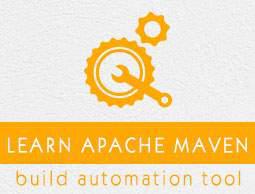Maven - Plugins
What are Maven Plugins?
Maven is actually a plugin execution framework where every task is actually done by plugins. Maven Plugins are generally used to −
- create jar file
- create war file
- compile code files
- unit testing of code
- create project documentation
- create project reports
A plugin generally provides a set of goals, which can be executed using the following syntax −
mvn [plugin-name]:[goal-name]
For example, a Java project can be compiled with the maven-compiler-plugin's compile-goal by running the following command.
mvn compiler:compile
Plugin Types
Maven provided the following two types of Plugins −
| Sr.No. |
Type & Description |
| 1 |
Build plugins
They execute during the build process and should be configured in the <build/> element of pom.xml. |
| 2 |
Reporting plugins
They execute during the site generation process and they should be configured in the <reporting/> element of the pom.xml. |
Following is the list of few common plugins −
| Sr.No. |
Plugin & Description |
| 1 |
clean
Cleans up target after the build. Deletes the target directory. |
| 2 |
compiler
Compiles Java source files. |
| 3 |
surefire
Runs the JUnit unit tests. Creates test reports. |
| 4 |
jar
Builds a JAR file from the current project. |
| 5 |
war
Builds a WAR file from the current project. |
| 6 |
javadoc
Generates Javadoc for the project. |
| 7 |
antrun
Runs a set of ant tasks from any phase mentioned of the build. |
Example
We've used maven-antrun-plugin extensively in our examples to print data on console. Refer Build Profiles chapter. Let us understand it in a better way and create a pom.xml in C:\MVN\project folder.
<project xmlns = "http://maven.apache.org/POM/4.0.0"
xmlns:xsi = "http://www.w3.org/2001/XMLSchema-instance"
xsi:schemaLocation = "http://maven.apache.org/POM/4.0.0
http://maven.apache.org/xsd/maven-4.0.0.xsd">
<modelVersion>4.0.0</modelVersion>
<groupId>com.companyname.projectgroup</groupId>
<artifactId>project</artifactId>
<version>1.0</version>
<build>
<plugins>
<plugin>
<groupId>org.apache.maven.plugins</groupId>
<artifactId>maven-antrun-plugin</artifactId>
<version>1.1</version>
<executions>
<execution>
<id>id.clean</id>
<phase>clean</phase>
<goals>
<goal>run</goal>
</goals>
<configuration>
<tasks>
<echo>clean phase</echo>
</tasks>
</configuration>
</execution>
</executions>
</plugin>
</plugins>
</build>
</project>
Next, open the command console and go to the folder containing pom.xml and execute the following mvn command.
C:\MVN\project>mvn clean
Maven will start processing and displaying the clean phase of clean life cycle.
[INFO] Scanning for projects...
[INFO] ------------------------------------------------------------------
[INFO] Building Unnamed - com.companyname.projectgroup:project:jar:1.0
[INFO] task-segment: [post-clean]
[INFO] ------------------------------------------------------------------
[INFO] [clean:clean {execution: default-clean}]
[INFO] [antrun:run {execution: id.clean}]
[INFO] Executing tasks
[echo] clean phase
[INFO] Executed tasks
[INFO] ------------------------------------------------------------------
[INFO] BUILD SUCCESSFUL
[INFO] ------------------------------------------------------------------
[INFO] Total time: < 1 second
[INFO] Finished at: Sat Jul 07 13:38:59 IST 2012
[INFO] Final Memory: 4M/44M
[INFO] ------------------------------------------------------------------
The above example illustrates the following key concepts −
Plugins are specified in pom.xml using plugins element.
Each plugin can have multiple goals.
You can define phase from where plugin should starts its processing using its phase element. We've used clean phase.
You can configure tasks to be executed by binding them to goals of plugin. We've bound echo task with run goal of maven-antrun-plugin.
Maven will then download the plugin if not available in local repository and start its processing.


